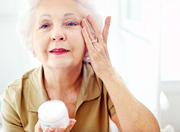 Photo: Getty Images
Photo: Getty Images
Every so many years, a new product comes out that claims to be a miracle cream to rejuvenate skin. DMAE joins the group. DMAE stands for dimethylaminoethanol and was first used as an oral supplement to boost “brain” function in areas of short-term memory, alertness, concentration and learning. It is found naturally in certain foods such as sardines and anchovies but its benefits and side effects have not been well studied.
Dr. Nicholas Perricone, M.D., a well-known dermatologist specializing in aging skin, sells several DMAE products on his website and endorses it as having benefits similar to facelifts. Others sources sell DMAE products as well but--do they really smooth your skin?
Perricone states that DMAE is secreted naturally in small amounts by the brain and acts as a precursor in the body’s production of acetylcholine. Acetylcholine is a chemical involved in muscle contraction. Some of facial skin sag is actually caused by loss of tone in the muscles underneath.
Perricone wrote in his blog “when DMAE is applied to the skin in a cream or treatment, DMAE can combat these signs of aging. This is because the acetylcholine that DMAE produces, works to increase muscle activity, thereby toning and strengthening the muscles behind the face.”
However, Perricone does not say how much DMAE is needed nor how long it takes to achieve this response. Also, it is unclear how much DMAE actually can be absorbed by skin to reach the muscles underneath when it is applied as a cream.
There are no specific clinical studies to support the use of DMAE and its effect, though according to physorg.com, there are several small studies that might indicate how DMAE can contribute to firming the skin.
At Laval University in Quebec, Pharmacologist Francois Marceau, M.D., found that when DMAE is applied, cells inside tiny compartments of the skin swelled while some died. Marceau said the swelling "is a likely explanation for the skin thickening, or firming,” which means that the DMAE is not getting to the muscle to exert its effect. Marceau published his study in 2007 in the British Journal of Dermatology.
Marceau indicated that he did not think there was tremendous risk in using DMAE but that it should be further studied. Risks to using DMAE creams are minimal but users should monitor for skin rashes or other allergic responses. Side effects reported when DMAE has been taken orally include headaches, irritability and tense muscles.
Cost for DMAE creams run from $13 to $135 for a two-ounce jar. As with many beauty products, it all relies on how much money you are willing to spend in the pursuit of youthful skin.
Sources:
www.skinway.com/skincare_articles/side-effects-of-DMAE.htm
www.healthcentral.com/skin-care/c/38641/16152/dmae-cell-death
www.smartskincare.com/tre atments/topical/dmae.html
http://blog.perriconemd.com/understand-the-science-behind-perricone-dmae/
www.physorg.com/news/2011-02-anti-aging-skin-creams-dermatologists.html
Michele is an R.N. freelance writer with a special interest in woman’s healthcare and quality of care issues. Other articles by Michele are at www.helium.com/users/487540/show_articles





Add a CommentComments
There are no comments yet. Be the first one and get the conversation started!